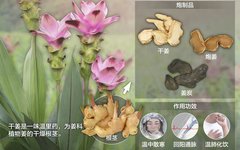Alias: Gan Jiang Pian (Dried Ginger Slices), Bai Jiang (White Ginger), Jun Jiang (Uniform Ginger), Gan Sheng Jiang (Dried Fresh Ginger)
Overview: Gan Jiang (Dried Ginger) is a warming herb used in Traditional Chinese Medicine (TCM), derived from the dried rhizome of the Zingiber officinale plant.
Main Functions: Warming the middle, dispelling cold, restoring yang, and warming the lungs to transform phlegm.
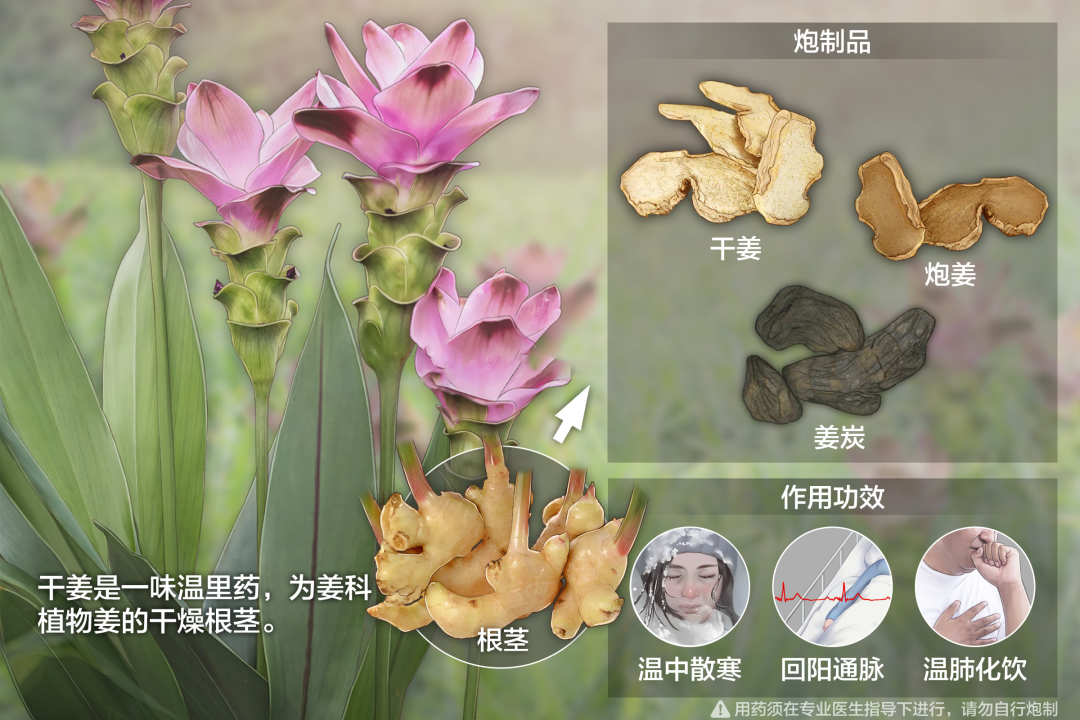
Typical Characteristics:
Gan Jiang is characterized by its pungent and hot properties. It enters the Spleen (Pi), Stomach (Wei), Kidney (Shen), Heart (Xin), and Lung (Fei) meridians.
Gan Jiang is pungent and warming, entering the Spleen and Stomach meridians, dispelling cold pathogens from the Spleen and Stomach, and assisting the yang qi of these organs. It is a key herb for warming the middle and dispelling cold, suitable for both excess and deficiency cold syndromes. It enters the Heart meridian, restoring yang and unblocking the vessels, often used with Fu Zi (Aconite) to revive yang and rescue from collapse. It enters the Lung meridian, warming the lungs and transforming phlegm, treating cough and wheezing due to cold phlegm. This herb mainly contains volatile oils: 6-gingerol, α-zingiberene, β-sesquiphellandrene, and others, with 6-gingerol being its spicy component; ginger carbon also contains gingerone. It has the effects of warming the middle, dispelling cold, restoring yang, and warming the lungs to transform phlegm.
Main Production Areas:
Primarily produced in Sichuan, Guizhou, Hubei, Guangdong, and Guangxi.
Parts Used:
This herb is the dried rhizome of the Zingiber officinale plant. It is harvested in winter, with the fibrous roots and soil removed, then sun-dried or dried at low temperatures. Freshly sliced and dried or low-temperature dried pieces are referred to as “Gan Jiang Pian” (Dried Ginger Slices).
Characteristics of the Medicinal Part:
Gan Jiang appears as flat blocks with finger-like branches, measuring 3-7 cm in length and 1-2 cm in thickness. The surface is grayish-yellow or light gray-brown, rough, with longitudinal wrinkles and distinct nodes. Branching areas often retain scale leaves, and the tips of branches have stem scars or buds. The texture is solid, with a cross-section that is yellow-white or gray-white, powdery or granular, with distinct annular patterns in the inner skin layer, and scattered yellow oil spots. It has a fragrant, unique aroma and a spicy taste. Gan Jiang Pian appears as irregular longitudinal or oblique slices, measuring 1-6 cm in length, 1-2 cm in width, and 0.2-0.4 cm in thickness. The outer skin is grayish-yellow or light yellow-brown, rough, with longitudinal wrinkles and distinct nodes. The cut surface is grayish-yellow or gray-white, slightly powdery, with many longitudinal fibers, some appearing hair-like. The texture is solid, with a fibrous cross-section. It has a fragrant, unique aroma and a spicy taste.
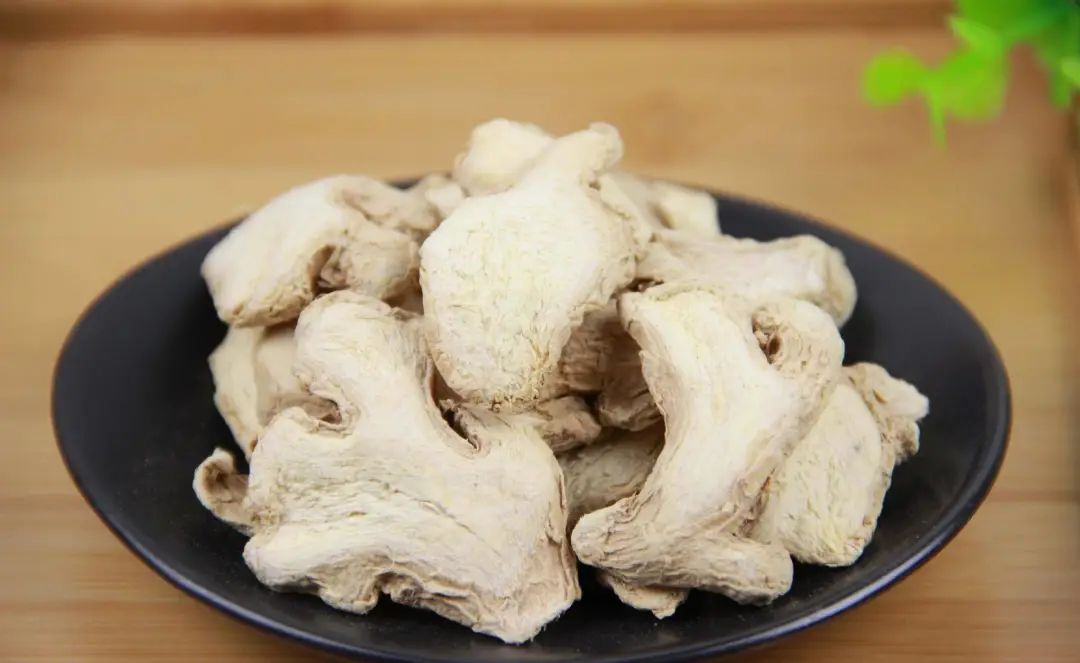
Literature Records:
“Shennong Bencao Jing”: “It is used for chest fullness, cough, and counterflow qi, warming the middle, stopping bleeding, inducing sweating, expelling wind-dampness, and treating diarrhea and dysentery. The fresh form is especially good.”
“Zhen Zhu Nang”: “Gan Jiang has four uses: 1) unblocking the heart and assisting yang; 2) dispelling cold and stubbornness from the organs; 3) expelling cold from the meridians; 4) treating abdominal pain due to cold.”
“Bencao Gangmu”: “Gan Jiang can guide blood medicines into the blood aspect and qi medicines into the qi aspect. It can also dispel evil and nourish the new, thus it is used for blood deficiency. For those with vomiting blood, nosebleeds, or bloody stools, it is also suitable, as it treats heat with heat, following the principle of treatment.”
“Yixue Rumen”: “Pao Jiang (Processed Ginger) warms the Spleen and Stomach, treating internal cold, diarrhea, dysentery, chronic malaria, cholera, cold pain and fullness in the heart and abdomen, stopping nosebleeds, spitting blood, bloody dysentery, and excessive menstruation.”
Effects and Efficacy:
Gan Jiang has the effects of warming the middle, dispelling cold, restoring yang, and warming the lungs to transform phlegm.
Indications:
Gan Jiang is used for cold pain in the abdomen, vomiting, diarrhea, cold limbs with weak pulse, and cough due to cold phlegm.
Spleen and Stomach Cold Syndrome:
It treats Spleen and Stomach deficiency cold, abdominal cold pain, often used with Dang Shen (Codonopsis), Bai Zhu (Atractylodes), and Fu Ling (Poria).
It treats cold pathogens directly affecting the organs, causing abdominal pain, which can be used alone or with Gao Liang Jiang (Galanga).
Yang Collapse Syndrome:
It is often used with Fu Zi.
Cold Phlegm Cough and Wheezing:
It treats cough and wheezing due to cold phlegm, with symptoms of cold body and back, and clear, thin phlegm, often used with Xi Xin (Asarum) and Wu Wei Zi (Schisandra).
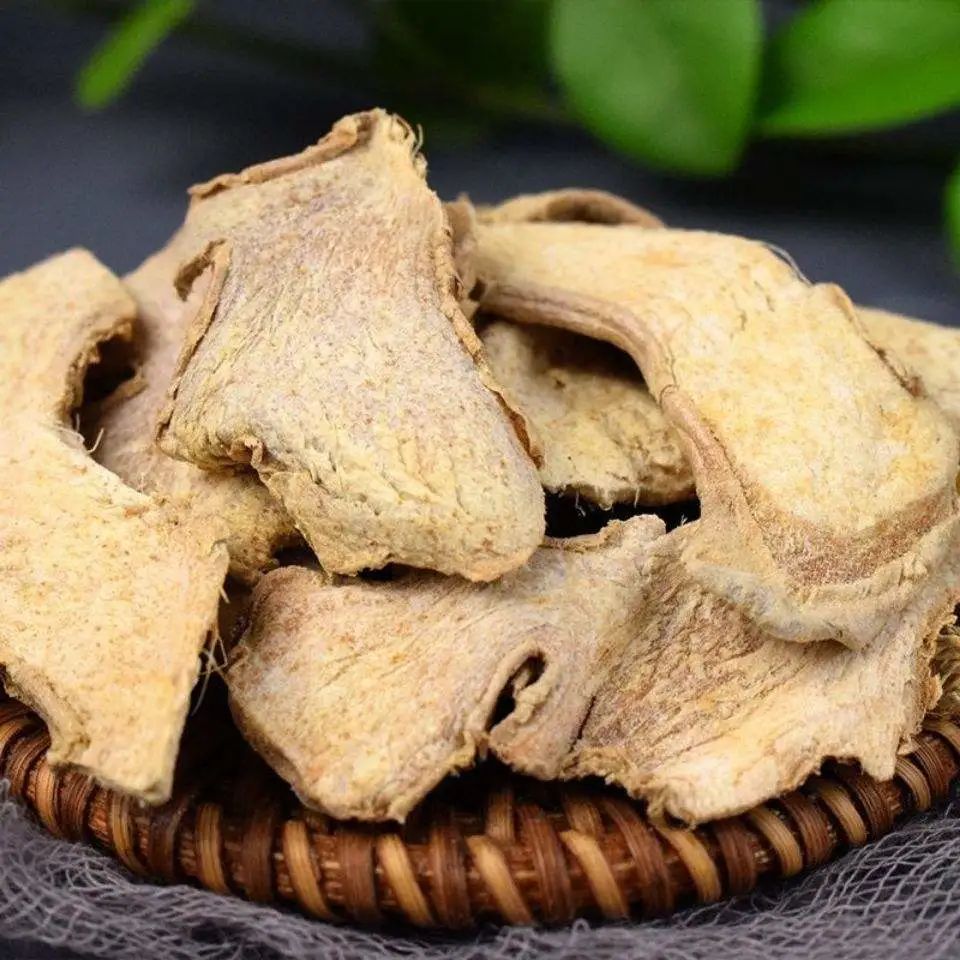
Modern Research:
This herb has various pharmacological effects, including anti-nausea, anti-ulcer, anti-inflammatory, anti-diarrheal, promoting gastrointestinal digestion, cardiotonic, pressor, analgesic, lowering blood lipids, protecting the liver and gallbladder, anti-hypoxia, sedative, hypnotic, and antibacterial properties.
Usage:
Gan Jiang is used for warming the middle, dispelling cold, restoring yang, and warming the lungs to transform phlegm. It is generally used in the form of dried ginger slices, decocted for consumption. Specific dosages should follow medical advice.
Processing Methods:
Gan Jiang:
Take the raw herb, remove impurities, soak briefly, wash clean, moisten, and cut into thick slices or blocks. Dry. Sift out fragments.
Pao Jiang:
First, place clean sand in a frying container, heat with strong fire until it is flexible, then add dried ginger slices or blocks, continuously stir-frying until they puff up and turn brown on the surface, remove, sift out the sand, and cool.
Ginger Carbon:
Take dried ginger slices or blocks, place in a frying container, heat with strong fire until the surface is charred black and the inside is brown, spray a little clean water to extinguish the sparks, stir-fry slightly, remove, dry, and sift out fragments.
Precautions:
Gan Jiang is hot and drying, so it should be used cautiously by pregnant women.
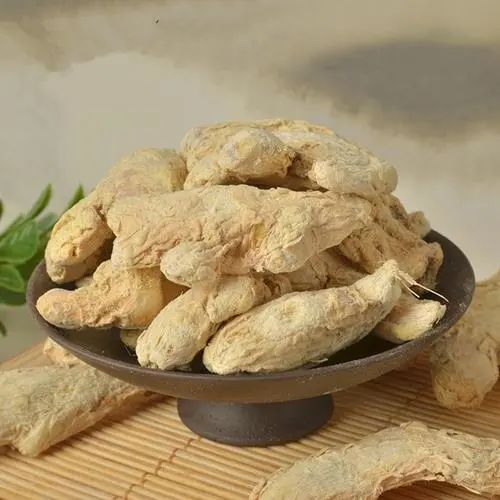
Identification of Medicinal Use:
Distinguishing between Sheng Jiang (Fresh Ginger), Gan Jiang (Dried Ginger), and Pao Jiang (Processed Ginger):
Sheng Jiang, Gan Jiang, and Pao Jiang all come from the same plant and can warm the middle and dispel cold, suitable for Spleen and Stomach cold syndromes. However, due to differences in texture and processing, their properties also vary.
Sheng Jiang is better at dispelling exterior cold and is considered a sacred herb for nausea; Gan Jiang is more focused on dispelling internal cold and is a key herb for warming the middle; Pao Jiang is good at entering the blood aspect and is effective for warming the meridians and stopping bleeding.
Distinguishing between Rou Gui (Cinnamon), Fu Zi (Aconite), and Gan Jiang:
Rou Gui, Fu Zi, and Gan Jiang all have pungent and hot properties, capable of warming the middle, dispelling cold, and alleviating pain, used for treating cold pain in the abdomen and diarrhea.
However, Gan Jiang primarily enters the Spleen and Stomach, excelling at warming the middle and dispelling cold, and stopping nausea; Rou Gui and Fu Zi have a sweet taste and are very hot, with strong pain-relieving properties, effective for severe cold pain in the abdomen and cold dampness obstructing pain syndromes. Both can also tonify fire and assist yang, used for treating Kidney yang deficiency and Spleen-Kidney yang deficiency syndromes.
Rou Gui can also guide fire back to the source, warm the meridians, and is used for treating floating yang, chest obstruction, yin sores, amenorrhea, and dysmenorrhea.
Fu Zi and Gan Jiang can revive yang and rescue from collapse, treating yang collapse syndrome. Fu Zi is stronger in this regard, while Gan Jiang is weaker, often used together. Gan Jiang can also warm the lungs and transform phlegm, treating cough and wheezing due to lung cold phlegm.
References:
[1] National Pharmacopoeia Commission. Pharmacopoeia of the People’s Republic of China (Part 1) [M]. Beijing: China Medical Science Press, 2020.
[2] Wang Jian, Zhang Bing. Clinical Chinese Medicine (2nd Edition) [M]. Beijing: People’s Health Publishing House, 2016.
[3] Zhou Zhenxiang, Tang Decai. Clinical Chinese Medicine (10th Edition) [M]. Beijing: China Traditional Chinese Medicine Press, 2016.
[4] Zhong Gansheng. Chinese Medicine (4th Edition) [M]. Beijing: China Traditional Chinese Medicine Press, 2016.
[5] Yan Zhenghua. Chinese Medicine (2nd Edition) [M]. Beijing: People’s Health Publishing House, 2006.
[6] Kang Yanguo. Chinese Medicine Identification [M]. Beijing: China Traditional Chinese Medicine Press, 2016.
[7] Xie Ming. Formula Studies (3rd Edition) [M]. Beijing: People’s Health Publishing House, 2016.
[8] Tan Xinggui. Chinese Medicinal Cuisine [M]. Beijing: China Traditional Chinese Medicine Press, 2003.
[9] Xie Mengzhou, Zhu Tianmin. Chinese Medicinal Cuisine (3rd Edition) [M]. Beijing: China Traditional Chinese Medicine Press, 2016.
[10] Ye Dingjiang, Zhang Shicheng. Chinese Medicine Processing Studies [M]. Beijing: People’s Health Publishing House, 1999.
[11] Gong Qianfeng. Chinese Medicine Processing Studies (10th Edition) [M]. Beijing: China Traditional Chinese Medicine Press, 2016.
[12] Wu Hao, Li Fei. Chinese Medicine Processing Studies (2nd Edition) [M]. Beijing: China Traditional Chinese Medicine Press, 2016.
Beijing Zhou’s Shizhen Hall Pharmaceutical Co., Ltd. was established in June 2008, focusing on the cultivation of Chinese medicinal materials, production of Chinese medicinal slices, research and development, sales, and providing specialized TCM medical services.
Beijing Dongbitang Traditional Chinese Medicine Museum is dedicated to inheriting and promoting TCM culture, carefully creating a comprehensive display of ancient TCM texts, manuscript prescriptions, tools, plaques, rare medicinal materials, medicinal specimens, and recreating TCM diagnostic and treatment scenarios, showcasing the characteristics of TCM culture from different periods.

